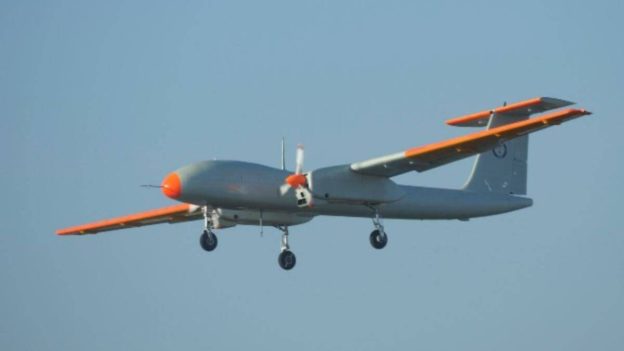The Indian government is reportedly prioritising the acquisition of drones, given concerns that both China and Pakistan are cooperating in drone production.
The strategic importance of drones and their ability to operate in conflict zones has been highlighted in recent conflicts, including the ongoing Russia-Ukraine conflict and the Armenia-Azerbaijan conflict. As a result, drones have taken centre stage at the Aero India 2023 event, with the DRDO’s TAPAS BH 201 generating significant buzz. The Indian government is reportedly prioritising the acquisition of drones, given concerns that both China and Pakistan are cooperating in drone production. Pakistan sees the use of drones in Kashmir as a potentially successful tactic, given their success in the region so far.
TAPAS BH 201 Drone: The Future of Intelligence, Surveillance, and Reconnaissance
Bharat Electronics Limited (BEL), a leading Indian aerospace and defence company, has developed the TAPAS BH 201 unmanned aerial vehicle (UAV) in response to the tri-services’ Intelligence, Surveillance, Target Acquisition, Tracking, and Reconnaissance (ISTAR) needs. The medium-altitude, long-endurance drone has an impressive flight endurance of several hours and successfully completed its maiden flight in November 2016.
MALE, or Medium Altitude and Long Endurance, unmanned aerial vehicles (UAVs) operate at altitudes between 10,000 and 30,000 feet and have a flight endurance of up to 48 hours. With a maximum take-off weight (MTOW) between 450 and 4,500 kg and payloads ranging from 100 to 500 kg, these UAVs typically use horizontal take-off and landing. Conversely, HALE, or High-Altitude and Long Endurance, vehicles are designed for advanced performance and fly at altitudes of 50,000-60,000 feet or higher. These sophisticated aircraft have a range of over 24 hours and typically have a MTOW exceeding 2,500 kg, and also use horizontal take-off and landing.
The TAPAS BH 201 drone, developed by Bharat Electronics Limited (BEL), has the capability to fly autonomously or via remote control, allowing for pre-programmed flight plans and operational use in daylight or darkness. Its compact, lightweight design makes it easily transportable and deployable to remote locations, while its real-time data collection and transmission provide valuable intelligence for decision-making. With a range of over 18 hours and altitude capabilities of up to 28,000 feet, the TAPAS BH 201 has already completed more than 180 flights and will be live-streaming aerial and static displays at Aero India 2023.
Formerly known as the Rustom-2, the drone has a 20.6-meter wingspan and a maximum speed of 225 kmph. It can cover a range of 250+ km using the C Band frequency data link developed by Defence Electronics Application Laboratory (DEAL) at DRDO, and 1000+ km via SATCOM using the Kᵤ Band frequency and GAGAN system.
The Defense Research and Development Organisation (DRDO) has developed a new ‘Tricycle Nose Wheel Type Retractable Landing Gear System’ for Unmanned Aerial Vehicles, which can withstand high touchdown speeds and rapid descents during landings. This development is expected to significantly reduce the cost of advanced indigenous drones. Currently, the Tapas BH-201 drone, equipped with foreign engines and mission sensors, costs around Rs 40-45 crore. However, an indigenous UAV engine is in an advanced stage of evaluation, according to sources.
India’s Archer-NG drone: An Upgrade for the Modern Battlefield
Archer-NG (Next Generation), an armed drone with a carrying capacity of 300 kg of weapons, including smart anti-airfield weapons and anti-tank guided missiles, is set to undergo its first flight test by June-July, sources say. This next-generation drone is an upgraded version of DRDO’s Rustom-1 drone and is capable of flying at altitudes of up to 22,000 feet. With a range of 220 kilometres and an endurance of 12 hours, the drone can perform conventional and auto take-off and landing. Apart from destroying targets, Archer-NG can also provide real-time, high-quality imagery and signal intelligence.
The upcoming Archer-NG drone is a significant achievement for India, given the country’s lag behind China and Turkey in the production of unmanned aerial vehicles. The upgraded version of the Rustom-1 drone, developed by DRDO, has an altitude capability of up to 22,000 feet, an endurance of 12 hours, and a range of around 220 kilometres. Capable of conventional and auto take-off and landing, Archer-NG can carry up to 300 kg of weapons, including smart anti-airfield weapons and anti-tank guided missiles. In addition to its target-destroying capabilities, the drone can also provide real-time, high-quality imagery and signal intelligence. The drone’s first flight test is expected to take place between June and July.
India’s Equation with Drones
India has fallen behind other countries in the development of advanced UAVs, leading to the importation of Heron and Searcher-II drones from Israel and the leasing of two MQ-9B Sea Guardian drones from US firm General Atomics by the Navy. India is focusing on developing indigenous advanced ground control stations that can operate six to seven home-grown UAVs, with Archer-NG being the latest drone capable of carrying more weapons and drawing inspiration from the Tapas-BH. Meanwhile, China has supplied Pakistan with armed Cai Hong-4 and Wing Loong-II drones.
Drones have become increasingly important in modern warfare due to their intelligence, surveillance, and reconnaissance capabilities. The TAPAS BH 201 drone, developed by Bharat Electronics Limited, is a medium-altitude, long-endurance drone that has an impressive flight endurance and real-time data collection and transmission capabilities. Finally, India’s Archer-NG drone, an upgraded version of DRDO’s Rustom-1 drone, is capable of carrying 300 kg of weapons and performing conventional and stealth operations. With China and Pakistan collaborating on drone production, the Indian government’s priority to acquire drones appears justified.
https://www.financialexpress.com/defence/aero-india-2023-indias-tapas-bh-201-drone-steals-the-show/2981878/





